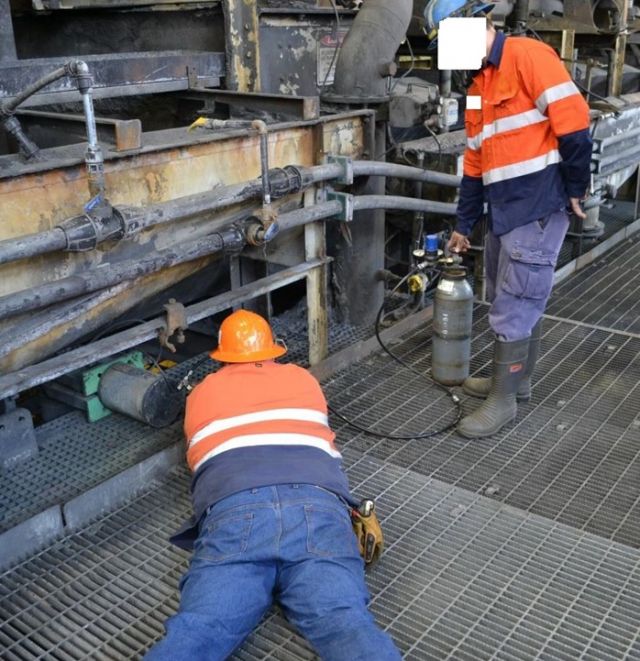
Mineral Mines & Quarries Inspectorate | Alert | No.459 V 1 | 29 September 2025
Failure of pneumatic actuator on knife-gate valve
Summary
- A worker at a concentrator suffered serious injuries when they were hit by the end cap of a pneumatic actuator for a knife gate valve when it detached under pressure.
- Two workers were attempting to free the knife gate using pressure from a nitrogen gas cylinder.
- The investigation is ongoing, and initial learnings are outlined below.
Issue Explained
- The knife gate valve was located at the base of a floatation bank and was normally used to drain the float bank when required. It was fitted with an 8” bore double-acting pneumatic actuator. This type of valve and actuator are commonly found in processing plants.
- The knife gate valve was normally operated pneumatically (air-powered) via the plant compressed air system using a directional control valve (DCV). The plant compressed air system at the concentrator operated at approximately 600kPa.
- The knife gate had become stuck sometime prior, and the two workers were tasked with freeing it.
- The workers were trying to free the knife gate using pressure from a nitrogen gas cylinder, fitted with a single-stage nitrogen regulator and connected to the actuator via ½” lines and fittings. The injured worker was positioned directly in front of the actuator due to the location of the valve and length of tubing available.
- A nitrogen ‘rig’, consisting of a D2 size nitrogen cylinder, single-stage regulator, lines, a ball valve and fittings had been previously used at the plant to help free stuck valves by providing the pneumatic actuator with greater gas pressure than the 600kPa plant air. This method had previously been used successfully.
- Initial investigations indicate the single-stage nitrogen regulator has experienced an event that has allowed an overpressure of the actuator.
- The body and end cap of the actuator were constructed from aluminium, with the end cap threaded into the body and a rated working pressure of 1,000kPa. The end cap separated from the body at this location (the joint).
- Initial testing indicated these types of pneumatic actuators experienced end cap separation at pressures of approximately 2,700kPa to 3,200kPa.
- Typical pressures for full D2 size nitrogen cylinders are 16,300kPa to 20,000kPa.
Learnings
- Overpressure events in pressure equipment can occur if the source of pressure is higher than the rated pressure of downstream components. It is possible for single stage gas pressure regulators to fail in such a way that allows an overpressure event to occur.
- Workers should be made aware that alternative methods for the freeing of stuck knife gate valves are available and should be assessed on risk and individual situations.
- Use of gas pressure to free stuck pneumatic devices such as pneumatically operated valves must be subject to appropriate engineering design and risk analysis to control overpressure hazards.
- Appropriate no-go zones or exclusion zones should be considered in risk analyses for work involving pressure equipment.
Investigations are ongoing and further information may be published as it becomes available. The information in this publication is what is known at the time of writing.
We issue Safety Notices to draw attention to the occurrence of a serious incident, raise awareness of risks, and prompt assessment of your existing controls.
References and further information
- Coal Inspectorate | Alert | No.452 V 1 | 23 October 2024 - Line of fire and exclusion zone failings
- Mines safety bulletin no. 139 | 28 January 2014 | Version 1 - Risk management of high pressure fluids and gases
- Mines safety alert no. 248 | 23 August 2010 | Version 1 - Facial impact injury from fuel tank cap releasing under pressure
- Petroleum and gas safety alert no. 43 | 21 September 2009 | Version 1 - Broken leg from coal seam gas sampling incident involving high pressure
- Mines safety alert no. 224 | 19 June 2009 | Version 1 - Flushing canister bursts
- Mines safety bulletin no. 67 | 31 May 2007 | Version 1 - Managing high pressure fluids and gases
- Mines safety bulletin no. 70 | 08 November 2007 | Version 1 - Hazards of stored energy
- Mines safety alert no. 113 | 22 April 2004 | Version 1 - Failure of plastic compressed air pipe fittings
- AS/NZS 1200 - Pressure equipment
- AS 1210 - Pressure vessels
- AS 2971 - Serially produced pressure vessels
- AS 3788 - Pressure equipment — In-service inspection
- AS 4343 Pressure equipment - Hazard levels.
- AS 4024, Safety of machinery, series of Australian Standards.
Contact: QldMinesInspectorate@rshq.qld.gov.au
Issued by Resources Safety & Health Queensland
Placement: Place this announcement on noticeboards and ensure all relevant people in your organisation receive a copy.
Find more safety notices
Search the hazards database


